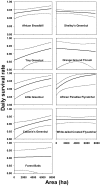Habitat fragmentation reduces nest survival in an Afrotropical bird community in a biodiversity hotspot
- PMID: 21709237
- PMCID: PMC3136281
- DOI: 10.1073/pnas.1104955108
Habitat fragmentation reduces nest survival in an Afrotropical bird community in a biodiversity hotspot
Abstract
Ecologists have long hypothesized that fragmentation of tropical landscapes reduces avian nest success. However, this hypothesis has not been rigorously assessed because of the difficulty of finding large numbers of well-hidden nests in tropical forests. Here we report that in the East Usambara Mountains in Tanzania, which are part of the Eastern Arc Mountains, a global biodiversity hotspot, that daily nest survival rate and nest success for seven of eight common understory bird species that we examined over a single breeding season were significantly lower in fragmented than in continuous forest, with the odds of nest failure for these seven species ranging from 1.9 to 196.8 times higher in fragmented than continuous forest. Cup-shaped nests were particularly vulnerable in fragments. We then examined over six breeding seasons and 14 study sites in a multivariable survival analysis the influence of landscape structure and nest location on daily nest survival for 13 common species representing 1,272 nests and four nest types (plate, cup, dome, and pouch). Across species and nest types, area, distance of nest to edge, and nest height had a dominant influence on daily nest survival, with area being positively related to nest survival and distance of nest to edge and nest height being both positively and negatively associated with daily nest survival. Our results indicate that multiple environmental factors contribute to reduce nest survival within a tropical understory bird community in a fragmented landscape and that maintaining large continuous forest is important for enhancing nest survival for Afrotropical understory birds.
Conflict of interest statement
The authors declare no conflict of interest.
Figures





Similar articles
-
Afrotropical montane birds experience upslope shifts and range contractions along a fragmented elevational gradient in response to global warming.PLoS One. 2021 Mar 30;16(3):e0248712. doi: 10.1371/journal.pone.0248712. eCollection 2021. PLoS One. 2021. PMID: 33784307 Free PMC article.
-
Ecology and life history predict avian nest success in the global tropics.Proc Natl Acad Sci U S A. 2024 Nov 26;121(48):e2402652121. doi: 10.1073/pnas.2402652121. Epub 2024 Nov 18. Proc Natl Acad Sci U S A. 2024. PMID: 39556725 Free PMC article.
-
Long-term demographic consequences of habitat fragmentation to a tropical understory bird community.Ecology. 2012 Dec;93(12):2548-59. doi: 10.1890/11-1345.1. Ecology. 2012. PMID: 23431586
-
Predators and the breeding bird: behavioral and reproductive flexibility under the risk of predation.Biol Rev Camb Philos Soc. 2009 Aug;84(3):485-513. doi: 10.1111/j.1469-185X.2009.00085.x. Biol Rev Camb Philos Soc. 2009. PMID: 19659887 Review.
-
Beyond tradition: a novel approach for edible bird nest cleaning and its processing.Vet Res Commun. 2024 Feb;48(1):29-37. doi: 10.1007/s11259-023-10235-6. Epub 2023 Oct 16. Vet Res Commun. 2024. PMID: 37840088 Review.
Cited by
-
Diversity and relative abundance of bird species in the two habitat types of Dokima forest Awi zone, Ethiopia.PLoS One. 2023 Mar 21;18(3):e0281595. doi: 10.1371/journal.pone.0281595. eCollection 2023. PLoS One. 2023. PMID: 36943851 Free PMC article.
-
High-speed railway infrastructure leads to species-specific changes and biotic homogenisation in surrounding bird community.PLoS One. 2024 Apr 10;19(4):e0301899. doi: 10.1371/journal.pone.0301899. eCollection 2024. PLoS One. 2024. PMID: 38598495 Free PMC article.
-
Impact of host age on viral and bacterial communities in a waterbird population.ISME J. 2023 Feb;17(2):215-226. doi: 10.1038/s41396-022-01334-4. Epub 2022 Nov 1. ISME J. 2023. PMID: 36319706 Free PMC article.
-
Afrotropical montane birds experience upslope shifts and range contractions along a fragmented elevational gradient in response to global warming.PLoS One. 2021 Mar 30;16(3):e0248712. doi: 10.1371/journal.pone.0248712. eCollection 2021. PLoS One. 2021. PMID: 33784307 Free PMC article.
-
Large forest patches promote breeding success of a terrestrial mammal in urban landscapes.PLoS One. 2013;8(1):e51802. doi: 10.1371/journal.pone.0051802. Epub 2013 Jan 2. PLoS One. 2013. PMID: 23300951 Free PMC article.
References
-
- Willis EO. Populations and local extinctions of birds on Barro Colorado Island, Panama. Ecol Monogr. 1974;44:153–169.
-
- Terborgh J. Preservation of natural diversity: The problem of extinction prone species. Bioscience. 1974;24:715–722.
-
- Andrén H. In: Mosaic Landscapes and Ecological Processes. Hansson L, Fahrig L, Merriam G, editors. London: Chapman and Hall; 1995. pp. 225–255.
-
- Kurki S, Nikula A, Helle P, Lindén H. Landscape fragmentation and forest composition effects on grouse breeding success in boreal forests. Ecology. 2000;81:1985–1997.
-
- Flaspohler DJ, Temple SA, Rosenfield RN. Species-specific edge effects on nest success and breeding bird density in a forested landscape. Ecol Appl. 2001;11:32–46.
Publication types
MeSH terms
LinkOut - more resources
Full Text Sources

